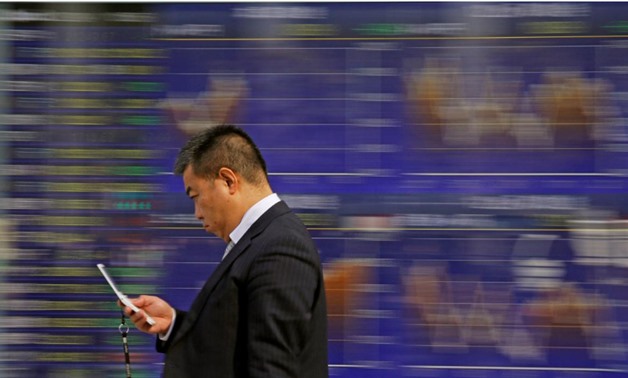
A man walks past an electronic stock quotation board outside a brokerage in Tokyo, Japan, February 9, 2018. REUTERS/Toru Hanai
LONDON - 9 May 2019: World shares tumbled for a fourth day running on Thursday after a warning from U.S. President Donald Trump that a long-worked-on trade deal with China was in serious danger.
Chinese Vice Premier Liu He was heading to Washington for two days of talks but Trump’s insistence that China “broke the deal”, and then Beijing’s response that it would retaliate against tariffs were ratcheting up the stakes.
Europe’s main stock markets sank almost immediately after a torrid day for Asia had battered 1.8 percent off China and more than 3 percent off South Korea, which is often seen as the bellwether for how this trade war hits home.
Both countries’ currencies were hit too, the won skidding to a more than two-year low and the yuan to a four-month trough, which kept traders buying the traditionally safe Japanese yen and U.S. and German bonds instead.
“Markets remain on edge ahead of the Chinese vice premier’s visit to Washington today,” Rabobank analyst Bas van Geffen said.
“Doubt that this tariff increase can be avoided is growing,” he added as Goldman Sachs also put the chance of a hike at 60 percent.
If talks do fall short, Washington has promised to raise tariffs on $200 billion of Chinese goods to 25 percent from 10 percent at 12:01 a.m. ET (0401 GMT) on Friday. For economists, the worry is that it will further slow the global economy.
Kazuhiko Fuji, senior fellow at RIETI, a Japanese government-affiliated think-tank, said the trade talks looked fragile.
“I would suspect the U.S. will just hand China an ultimatum. No wonder the U.S. yield curve is almost inverting again,” he said.
The yield spread between three-month U.S. government bonds and the 10-year notes shrank to 3 basis points, compared with about 15 basis points a few weeks ago.
The closely watched spread turned negative in late March, spooking investors, who read the development as portending a recession.
The benchmark 10-year Treasury yield stood at 2.4423 percent in Europe, having touched its lowest level in five weeks of 2.426 percent on Wednesday.
Wall Street futures pointed to a 0.85 percent lower start after a choppy previous session had seen the Dow Jones Industrial close fractionally higher but the S&P 500 and Nasdaq drop 0.2 percent and 0.3 percent.
TAXI!
As well as the trade headlines, traders will also be closely watching the pricing on ride-hailing firm Uber’s initial public offering, which is set to be the biggest of the year so far.
“In the event of a complete breakdown in talks and higher tariffs, we would expect this to see U.S. stocks trade 10–15 percent below their highs and a fall of around 15–20 percent in the Chinese market,” Mark Haefele, global chief investment officer at Global Wealth Management at UBS, said.
In the currency market, the Japanese yen surged to a three-month high of 109.64 yen while China’s yuan fell half a percent to hit a four-month low of 6.838 and was headed for its worst four-day decline in a year.
Sterling, meanwhile, tried to brush off signs that Brexit talks between Britain’s government and the main opposition party may soon collapse to claw back above the psychologically key $1.30 level.
Commodity markets also felt the U.S.-China trade strains.
Brent crude futures dropped 0.6 percent to $69.92 a barrel, while U.S. West Texas Intermediate crude also retreated 0.6 percent to $61.75 despite a surprise fall in U.S. crude stockpiles.
Benchmark London copper hit its lowest in nearly three months, going as low as $6,111 a tonne.


Comments
Leave a Comment